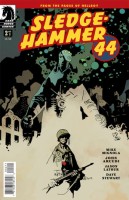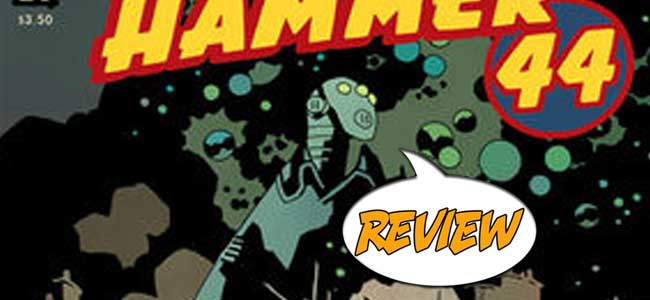Mike Mignola has created a little empire around his Hellboy story continuity, and well-deserved, I would say. It really highlights the strengths of having a single writer/creator on the tiller for the whole run and the ability to keep a consistent vision. Occasionally, Mignola does allow others to play in his sandbox. Here he teams with occasional collaborator John Arcudi on the latter’s idea for a story set on the battlefields of WWII Europe. Is it a good, spooky story, or does it just further blur the line between Hellboy and Atomic Robo? Find out after the jump.
 SLEDGEHAMMER 44 #2
SLEDGEHAMMER 44 #2
Story: Mike Mignola, John Arcudi
Artist: Jason Latour
Colorist: Dave Stewart
Letterer: Clem Robins
Editor: Scott Allie
Publisher: Dark Horse
Cover Price: $3.50
Previously in Sledgehammer 44:
In the World War II of the Hellboy continuity, a squad of American soldiers acts as the support team for a mechanical man called Sledgehammer as they range behind enemy lines to battle Nazis. Sledgehammer is an occult-punk robot powered by Vril power and operated by the “soul” of a “dead” soldier (okay, the specifics aren’t exactly clear on that point, but like many things in this story–just go with it). As this issue begins, Sledgehammer has been rendered immobile after a battle with a Nazi mecha and the squad, attempting to return him back to base, has been captured by German soldiers.
“TRUST ME, I KNOW WHAT I’M DOING.”
There’s a formula for a classic Hellboy short story: Hellboy shows up, fights a ghost, and gets beaten badly. Meanwhile/coincidentally, the ghost resolves the problem that made it a ghost in the first place and the whole place implodes. Hellboy leaves on a bittersweet note. It’s more a way to showcase “this great ghost story idea I had” than to tell a complete story. Not that I’m complaining. I like these stories–they’re fun as long as they stay short. At two issues, Sledgehammer 44 is just within the tolerable limit for that type of story.
Minimal spoiler version:
In this issue the team of iconic soldier stereotypes is caught between a Panzer tank and a hard place. They manage a miraculous escape only to find themselves in an even more hopeless situation. A “ghost” shows up and happens to provide a way out. In the end those that survive are sad. It’s a good ride with suspense, mystery and pathos. There’s a lot of great ambiance but not a lot to sink your teeth into.
Somewhat spoilery criticism:
There’s a difference in storytelling between “I wonder why that character did that” and “I don’t know what’s going on” but that difference is not always clear. In the climax of this book, one of the soldiers has to make a decision–classic story construction. The problem is that I don’t know how he made the choice. Was it a difficult choice to make? I don’t see what the dilemma was. Is it about giving up his humanity? Because there’s not much about that in the text. Or is it about sacrificing yourself for your brothers in arms? In that case he’s already made the sacrifice before having to make the decision. I don’t need everything in the story spelled out, but this is the climactic turning point of the whole tale so I think there should be a little more to it.
(I apologize for being so obtuse, but, website title aside, I really don’t like to put outright spoilers in these reviews.)
OH, WON’T YOU SHOW FOR ME?
The art is suggestive of Mignola’s style, but much more detailed. It actually reminds me of a cross between Mignola and Kyle Baker, which is not a bad thing. The extensive line-work gives the book a gritty feel that captures the harsh reality of the battlefield. The coloring is… interesting. The book mostly uses a low-contrast, limited palette, which is a common trait for books in the Hellboy-verse although I don’t think it is used here to as good an effect. The low-contrast in particular looks cool but drains some of the emotion from the scenes. Not all of it, but still I feel that the colors didn’t strengthen the story.
THE BOTTOM LINE: This can be my testimony
I give Sledgehammer 44 #2 three and a half stars—good, but I feel like something was missing. In the end, I’m not sure why it was a two issue mini-series. It could have been a tight, enigmatic one-shot that left you with wanting more. Or it could have been a four to six issue, trade-ready arc that delved into backstories and delivered a satisfying ending. I recommend it, but unless you’re a Hellboy or WWII fan, it won’t be at the top of the stack.
DID YOU READ THIS ISSUE? RATE IT!
Reader Rating
[ratings]



